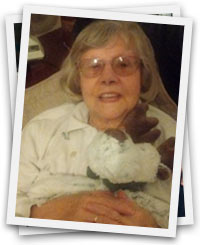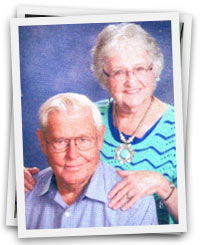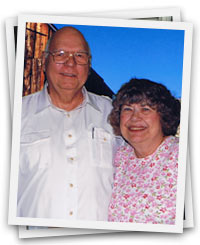The following stories are those of real caregivers who have extensive first-hand experience with creating and updating a care plan for their loved ones. Each caregiver has provided a bit of tried and tested advice for facilitating individual daily activities, staying organized, or involving family members and professionals in a care plan. Whether you are providing care by yourself or you have the support of a large network of people, it is crucial to set realistic goals each day, ask for help, and periodically assess your care plan and team to see if they can be improved.
See if any of the following guidance can assist you in laying out your own care plan:
Caregiving in Paradise—Kailua, HI
 |
| Ken and Charlotte in Hawaii |
Ken has been caring for his wife, Charlotte, for 13 years of their 48-year marriage. Charlotte was initially diagnosed with Alzheimer’s disease, but six years later, doctors concluded that her cognitive impairment and other symptoms were actually caused by normal pressure hydrocephalus (NPH). Although surgery corrected the NPH, she suffered brain damage during the long period that she was misdiagnosed.
Care Plan Type: Formal
Care Team Members: Adult children, extended family, social worker, adult day care staff, and fellow caregivers
Bathing and Hygiene: “I bathe my wife daily and each member of our care team is trained to provide her proper toileting techniques. We brush her teeth and use a water pic to get any missed residue.”
Recreation: “She is socialized at adult day care during the day, and her family visits at least one day a week. We also play music from her era, and she likes to sing along when she can.”
Respite: “I advocate for caregivers and do caregiver counseling in my home for free. I also run my own support group.”
Pro tip: “Form a unified team of family and friends you can call on for help. Not everyone will be capable of doing everything, so focus on their individual strengths. Our care plan is a carefully documented plan of action that most members of our ‘care network’ can follow in case something happens to me.”
Jude and her Mum—Southampton, U.K.
 |
| Jude's Mum and her sleeping companion, Rudi |
For five years, Jude has been a live-in caregiver for her mother who suffers from mixed dementia and personality disorder. Jude’s Mum won’t accept outside care, and although their care team is rather small, Jude takes advantage of supportive services available in her community.
Care Plan Type: Casual
Care Team Members: Daughter, fellow churchgoer, elder law attorney
Financial Responsibilities: “I’m Mum’s financial Power of Attorney, so I do it all. My daughter is also POA, and I share the books with her periodically so she is well informed.”
Medical Care: “I receive Mum’s medications in pre-sorted dosette boxes direct from the pharmacy and have her regimen reviewed at least once per year. I also set up alerts on my PC to remind me a month before Mum is due for any checkups or tests so I can schedule her appointments in time.”
Pro Tip: “Caregivers should have to meet with other caregivers. Do your research to fully realize what the road they are about to embark upon involves in the short term and the long term. Existing carers should realize that, without a plan, their day has no structure. A template of daily care is really useful.”
Family is Forever—Kent, U.K.
 |
| Mac and Lucy-Caitlyn |
It is truly an admirable feat when a caregiver struggles with their own health issues and still manages to provide care for someone else. This is the case for Lucy-Caitlyn, who cares for her widowed brother-in-law, Mac. With the help of professional caregivers and Lucy-Caitlyn, Mac is able to live in his own home in spite of his dementia diagnosis.
Care Plan Type: Casual organizational tool to supplement professional care
Care Team Members: Social worker, support workers (home care)
Meals: “Mac has problems swallowing and is not motivated to eat. To help with this, we make tiny portions of food and serve them on unusual items. For example, a sandwich cut with cookie cutters and served on a saucer, or a small portion of casserole in a teacup. This makes it appear not to be a ‘meal’ and stops mealtime anxiety from building up.”
Respite: “Unless there is an emergency, I have each Sunday to myself. I have no contact with anyone from 10 PM Saturday through 8 AM Monday. This is vital for me to recharge my batteries. It took time for Mac to accept it, but it is now routine and he will say, ‘Sunday’s coming—your day off!’”
Pro Tip: “When first setting up Mac’s plan, I, in consultation with him, wrote a list of ideals and a list of no compromises. From these two lists, we devised a care plan that was attainable financially and emotionally. But, be aware that your needs change too. I have a care plan for me, written and executed by me to ensure I remember that I need taking care of too, and a healthy me leads to a better cared for brother-in-law.”
Hospice at Home—Hyde Park, NY
 |
| Peggy and her husband |
Peggy has been caring for her husband for four years. He is mentally sound, but suffers from advanced chronic obstructive pulmonary disease (COPD), emphysema, and atrial fibrillation (A-fib). Peggy’s husband has been receiving hospice care for a little over six months, so their routine is unique compared to some of the others detailed here. He no longer goes to doctor’s appointments and is housebound since comfort measures are their main objective at this point.
Care Plan Type: Casual daily to-do list supplemented by hospice
Care Team Members: Hospice nurse and hospice social worker
Bathing and Hygiene: “After I set up all his things, he can shave himself. From time to time I wash his hair and give him a shower as well as cut and clean his nails. I have someone come in to give him a haircut. My husband is very resistant to being bathed, so I wish I had help. Hospice can supply an aide once a week to do this, but he does not want a stranger seeing him naked.”
Medications: “I pour his morning and evening medicines, set up his inhaler and monitor his water intake every day. I also keep track of when medications and supplies need to be reordered, including his oxygen.”
Respite: “I am still able to leave my husband for several hours if I set him up with everything beforehand. It is very difficult to leave him overnight or go away for more than a few hours, though.”
Pro tip: “Get help, take care of yourself and be flexible.”
Regular Assessment is Key—Glassboro, NJ
 |
| Michele's mother-in-law and husband |
Caregiving is a unique and demanding job, and there is some sort of learning curve involved for each and every caregiver. Michele helped her husband care for his mother with COPD and lung cancer for about a year and a half. Although the routine they developed worked well, it wasn’t until after Michele’s mother-in-law passed that she recognized a few flaws in their plan.
Care Plan Type: Casual daily routine
Care Team: Husband, other family members
Medical Care: “I wish we had had a geriatric care manager to consult with, but we never knew how to set that up. I also wish we had gotten hospice care sooner than two days before my mother-in-law’s death. It was really difficult to get the doctors to prescribe it. We asked her pulmonary and primary doctors, but they always skimmed over and avoided the question.”
Pro Tip: “Get a geriatric specialist involved instead of just a primary doctor. Form a support team well in advance because things can change very quickly. Seek as much help as possible because caregiving can be very stressful! Definitely don’t be shy when asking for assistance either.”
Ferris and John’s Story—Sun City, AZ
 |
| Ferris and John |
In 2009, Ferris’ husband John was diagnosed with dementia. With a background in nursing, social work, and law, Ferris was relatively well prepared when she took up the caregiver mantle. John is 89 now, and as his sole caregiver, Ferris focuses on doing anything she can to make his remaining days comfortable and joyful.
Care Plan Type: Flexible routine
Care Team Members: None
Meals: “My husband has trouble focusing in the morning. When I would ask what he wanted for breakfast, he would draw a blank. So, I made a laminated menu just like in a restaurant that shows choices for eggs, sides, toppings, etc. This takes the confusion out of the equation and he can just point to what he wants. It makes my job easy and relieves him from having to make a decision, which can be difficult for someone with dementia.”
Bathing and Hygiene: “I try to have him shower 2-3 times per week, but this is sometimes a struggle when he thinks he has taken a shower the day before. I solved this by marking a red dot on the calendar to prove to him which days he has showered.”
Pro Tip: “My biggest suggestion is to ask your loved one what they want to do about their care (if they can still communicate). Try something, and if it fails, then try something else. You have to know their limits and yours as well. At this point in time, I’ll be able to handle things myself, but I’ve already created a list of professional caregivers that can come into our home, and I have inspected an assisted living facility.”
Know when to Ask for Help—Georgetown, TX
 |
| Mary Ann and her husband |
Mary Ann has been caring for her husband with late-stage Alzheimer’s disease for five years. In spite of his diagnosis, he is still relatively independent and helps his wife maintain their 30-acre property. Mary Ann faces some health issues of her own, but she still finds the energy to care for an elderly aunt who resides in a nearby nursing home and a close friend in assisted living.
Care Plan Type: In transition from casual to formal
Care Team: Adult children, family dog, friends, elder law attorney, and cleaning lady
Planning for the Future: “I am in the process of improving my care plan. My husband has an upcoming appointment for a complete physical at a VA facility to determine if he can get additional help for his Agent Orange exposure in Vietnam. If all goes well, I will call a home care agency to help me put a formal care plan in place. When the time comes, I have found a memory care facility that I think is good. His name is on the wait list, but I won’t place him until the time is right.”
Activities: “My husband likes to walk our dog and does that at least twice each day. He has a stent in his heart, and it is important for him to exercise. He really loves our dog. Without her, he would be lost.”
Pro Tip: “Do whatever you can to keep your loved one as active as possible—especially as you take over some of their responsibilities. I am hoping that when I do get home care that I can get a male caregiver to tinker with him. My husband has a wonderful workshop and used to build furniture. Although he doesn’t do that anymore, there are small projects that he could work on with proper supervision.”
Support is Key—Hurricane, UT
 |
| Anita and her husband |
Anita has been the primary caregiver for her husband with Lewy Body dementia and Parkinsonism for two years. Although she makes the most of the resources available in her community, she is no longer able to safely leave her husband unattended and she does not drive. This has resulted in the couple being somewhat isolated at home. Anita has recently decided that it is time to use their long-term care insurance policy and she is now in the process of applying for in-home health care to help them with day-to-day tasks.
Care Plan Type: Casual, but in transition to formal
Care Team Members: Adult daughter, online support groups, cleaning lady, and hopefully in-home care
Bathing and Hygiene: “At this point he is able to take care of these tasks himself, except that it really wears him out. He has to take a nap between each step.”
Medications: “I keep all of his medications in a locked box. Once a week I put a week’s worth of pills into a pill organizer. I wake him for his morning meds at 9 AM, served in a paper cup with a protein drink. He usually goes back to sleep for a bit afterwards.”
Meals: “Because he eats at such irregular times, I have ‘meals on wheels’ delivered and can warm them up in the microwave as needed. Every Sunday our daughter brings us dinner.”
Respite: “I knit or work on my novels. I can’t leave him alone anymore since he tried to make a grilled cheese sandwich, forgot about it and it burned to a crisp. I wish I could have someone stay with him on Wednesdays so I could go out with my daughter for shopping, a dentist appointment, or just to go to lunch.”
Pro tip: “Join a caregivers’ group, either in your area or online. Learn all you can about your loved one’s malady so you can be as prepared as possible for what is to come. If you have long-term care insurance, get started early on to activate it, and make sure you have POA for health and finances.”